Awesome Aurorae, Gorgeous Luna Grows in Evening, Planets Parade in the Pre-Dawn, and Big Dipper Benefits!
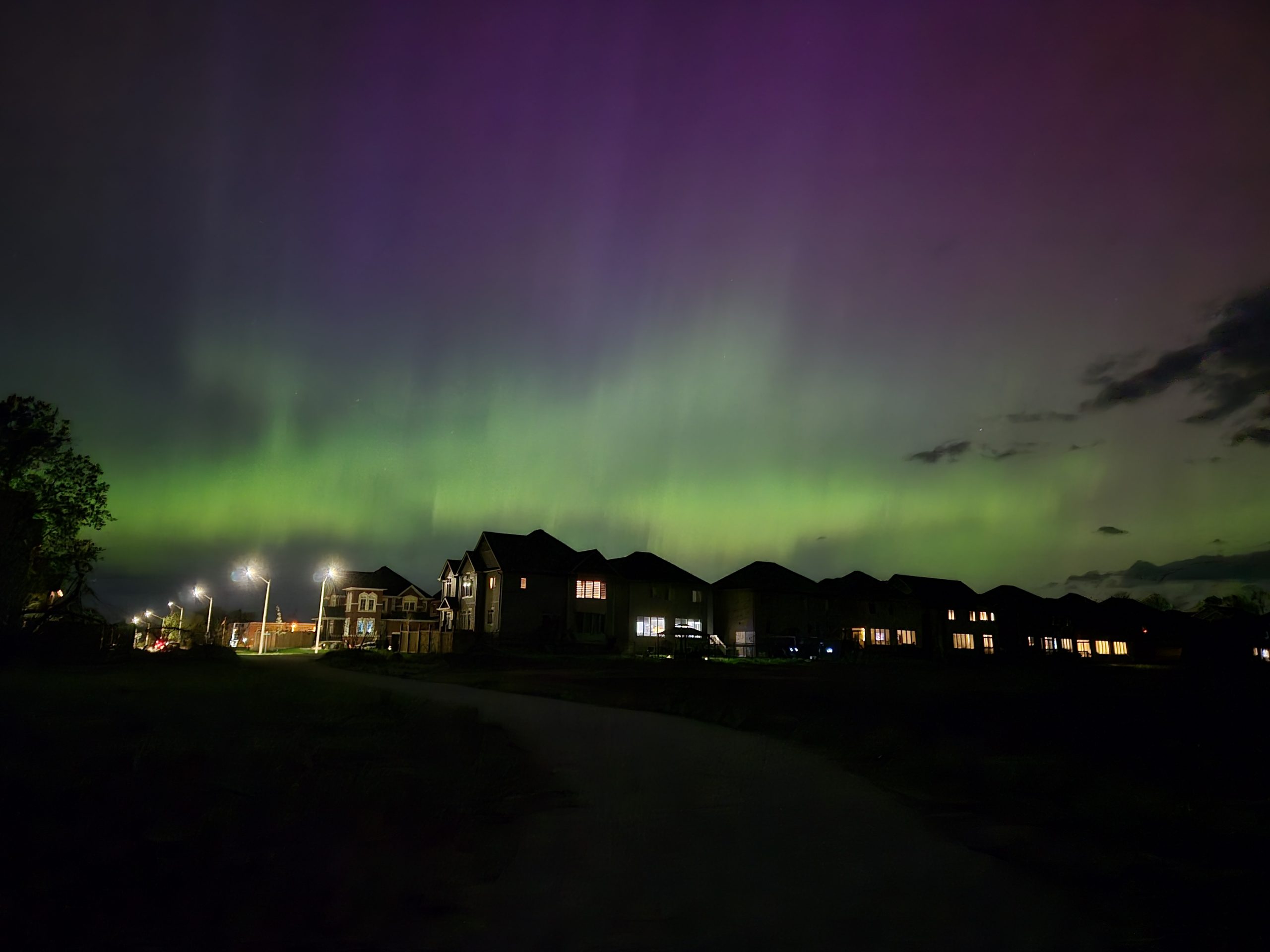
I captured this image of the once-in-a-lifetime aurora borealis on May 10, 2024 at 10:41 pm, from the trail behind my house in Collingwood, Ontario, Canada. Despite somethin cloud we were able to see the aurorae in motion. The green glow is from singly ionized oxygen. The blue arises from nitrogen and the purples come from mixing in doubly ionized oxygen. (Handheld Samsung Galaxy S24 in night mode).
Hello, Mid-May Stargazers!
Here are your Astronomy Skylights for the week of May 12th, 2024 by Chris Vaughan. Feel free to pass this along to your friends and send me your comments, questions, and suggested topics. You can also follow me on Twitter as @astrogeoguy! Unless otherwise noted, all times are expressed in Eastern Time. To subscribe to these emails please click this MailChimp link.
If you’d like me to bring my Digital Starlab portable inflatable planetarium to your school or other daytime or evening event in Simcoe, Grey, and Bruce Counties, or deliver a virtual session anywhere, contact me through AstroGeo.ca, and we’ll tour the Universe, or the Earth’s interior, together! My book with John A. Read entitled 110 Things to See With a Telescope is a guide to viewing the deep sky objects in the Messier List – for both beginners and seasoned astronomers. DM me to order a signed copy!
I explain what’s up (literally) with the aurorae recently. The moon will return to shine prettily in the evening worldwide this week. As it brightens the faint stars will become hidden, but the bright ones in the Big Dipper will remain to guide you to others. The brightest planets are now hidden close to the sun, but Saturn and Mars will appear easily in the east before dawn, with faint Neptune between them. Read on for your Skylights!
Activated Aurorae!
You may have noticed that images and videos of the Northern Lights, technically the aurora borealis, have been popping up more on social media recently. That’s because night mode on our smartphone cameras has improved a lot, and because the sun, the source for those night-time displays, is delivering on its current solar maximum. The accounts of sky-watchers and astro-imagers living at mid-northern latitudes were leaded with them this weekend due to a major geomagnetic storm! Let’s look at the physics and astronomy behind those glorious displays, part of what astronomers call “space weather”.

The intense fusion reactions inside the sun and the flow of ionized particles (mainly Hydrogen atoms split into their components of one proton and one electron) combine to give the sun an intense magnetic field. Since the sun is a sphere of compressed gases, and not a solid ball like Earth, its rotation is differential. A point on the sun’s equator will circle the star once in 24.47 Earth days, but a point close to its northern or southern pole will take almost 38 days! The sun’s average rotation period of 28 days closely matches our moon’s orbital period – but that’s a mere coincidence of nature.
The differential rotation causes the sun’s global magnetic field to wind up tighter over time. Magnetic fields can’t merge or cross one another. (That’s why it’s difficult to push the same poles of two magnets together.) As the sun’s field tightens up, small regions within it develop tangles of magnetism that prevent the heat beneath them from flowing out of the sun. Those cooler areas are visible from Earth as sunspots. Astronomers formally call them active regions, and number them.
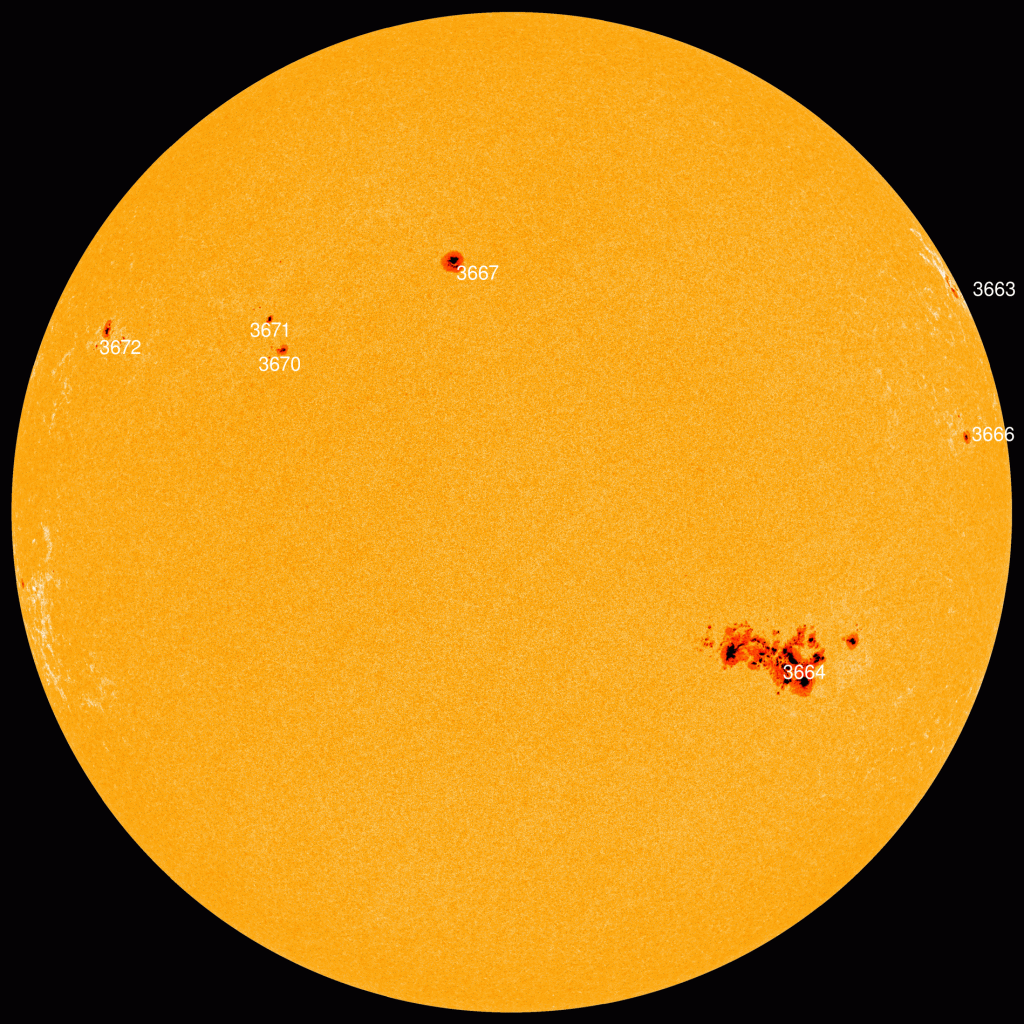
Sunspots can develop, grow, and fade within hours and days – or persist for weeks. Viewed from Earth, they take about two weeks to cross the sun’s disk – allowing us time to see them evolve. Scientists have also placed satellites on the far side of the sun to watch the solar hemisphere that we can’t see. That’s because, from time to time, the buildup of energy in those tangles gets violently released as solar flares, and as eruptions of charged matter into space called coronal mass ejections (or CME’s for short). Those events, which happen in minutes, cause the auroras at Earth’s polar regions to grow stronger. They also endanger orbiting astronauts and satellites with intense radiation – if Earth happens to be in the line of fire. The flares vary in intensity. They are ranked by class, from weak A-class to extreme M- and X-class. During a flare, the sun’s magnetic field lines are snapping and re-connecting into simpler configurations.
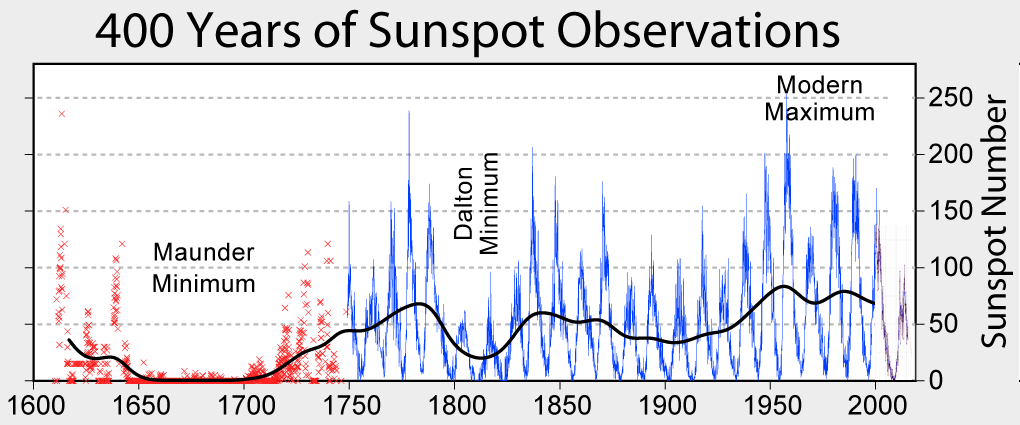
Over a period of time, more and more spots appear, and more and more violent events occur. Eventually, the sun sheds its excess energy, the magnetic fields smooth out, and the sun settles into a quiet period with no, or very few, sunspots and flares. Astronomers have been able to view the sun through filters, count the sunspots, and record their number in a log. It turns out that the sun needs about 11 Earth-years to build up and then wind down. Even more interestingly, the polarity of the magnetic field reverses with each sunspot cycle, producing a 22-year period between true cycles. I’ll post a 400-year-long sunspot count graph here. There are lots of online sources showing graphs of the counts, including this page of recent ones and this one. At the far right end of the graph you can see how the sunspot number has recently been climbing over time.

The name Aurora Borealis, Latin for northern lights, was coined by Galileo in 1619. (Aurora was the Romans’ goddess of the dawn.) He did not know then that there were also Aurora Australis visible at southern latitudes. The aurorae work in a similar way to neon lights and fluorescent tubes. If you add energy to certain gases, their outer-shell electrons absorb the energy by jumping to a higher state. Since they don’t like to stay there, they relax and shed the energy as a photon of light at a specific wavelength (or colour) of light.
If the clouds of energetic particles produced by CMEs reach Earth – most of them miss us – they are stopped and deflected towards our north and south magnetic poles by the Earth’s protective magnetic field, which has a distorted apple-shape. The field’s outer “skin” extends well above our atmosphere, into space. But the magnetic field drops lower and penetrates the Earth’s surface at our northern and southern magnetic pole – the way the apple’s skin pinches inwards towards its core at top and bottom.
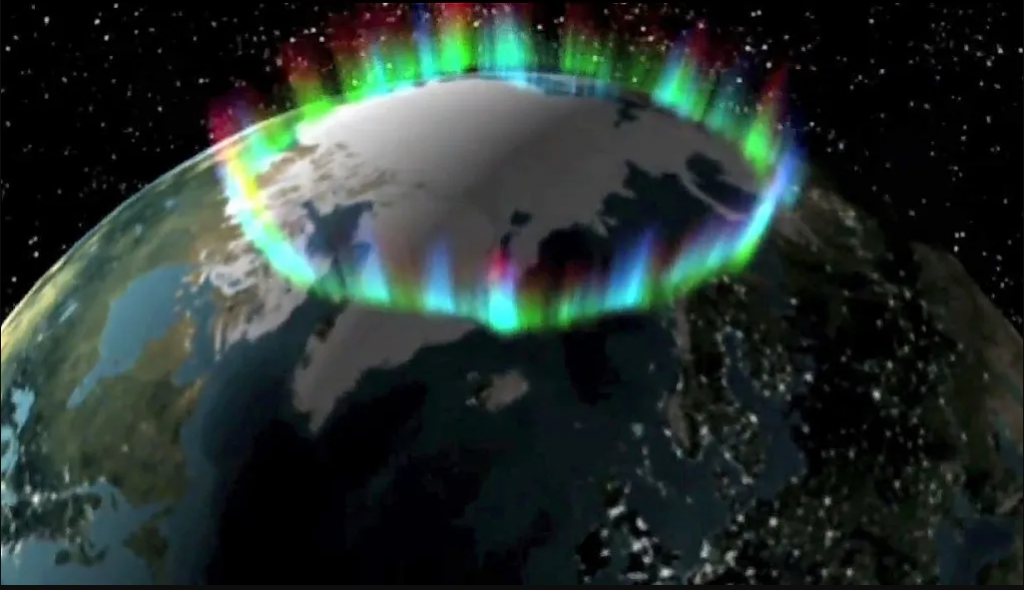
The sun-facing side of the Earth’s field is pushed somewhat towards the Earth’s surface (flattened) by the pressure of the Sun’s constant solar wind. The side pointing away from the Sun is pulled further away from the Earth’s surface and forms an elongated “tail”. (The whole system resembles a drop of water with a rounded nose and pointed rear). The shape of our field always keeps the elongated “tail” facing away from the Sun while the Earth rotates inside of it.
When the deflected charged particles from the Sun become channeled down into the pinched areas near Earth’s poles, they gain intensity and come in contact with atoms and molecules comprising our atmosphere, causing those gases to glow! Yellow-green colours are oxygen molecules emitting 557.5 nanometre light about 100-300 km above the ground. Human eyes are tuned to this colour range. The concentration of atomic oxygen drops off below 100 km.
Blues, pinks and dark red arise from nitrogen atom lines between 391 and 470 nm, about 100 km up. Reds lines at 630 and 636 nm occasionally arise from more strongly ionized oxygen atoms above 300 km. Nitrogen molecules produce 428 nm blues and some magentas, which are harder for human eyes to detect. The other colours we see arise from the blending of red and blue to make pink, yellow, etc.

The shimmering and colour changes that we see in auroral displays occur as the intensity of the solar material and the density of our atmosphere varies – just like wind on a breezy day moves some branches, then others, then none at all.
The aurorae actually form lopsided rings surrounding each of Earth’s magnetic poles. (Jupiter and Saturn have auroral rings, too.) When the solar particles are less energetic, they need to be concentrated more to produce the glow, so the auroral ring becomes smaller and hugs the magnetic pole (i.e., farther north). When the Sun emits a strong burst of energy our way, the ring expands much farther from the poles – allowing us to see aurorae at lower latitudes!
The nights around the March and September equinoxes offer a higher likelihood of aurorae. Just as two bar magnets lined up with their poles in the same direction repel one another strongly, the Earth’s magnetic field repels the sun’s field. At the equinoxes, the Earth’s axis tilts partly sideways compared to the sun, so the two “magnets” aren’t lined up as well, reducing Earth’s ability to deflect the sun’s field and the charged particles that trigger aurorae in our upper atmosphere.
Scientists can alert us when the chance of aurorae is higher because solar observing satellites can detect an increase in the Sun’s output immediately, but the energetic particles take several days to arrive at Earth. The website www.spaceweather.com provides a measurement called the Kp Index and a map of the current aurora ring position for North America. Scroll down on the left side of the page. Remember that as the Earth turns, various longitudes take turns being under the ring. The trick is to be there while the sky is both dark and clear!
You can sign up for email alerts at Spaceweather.com, follow @SpaceWeatherCA (and other accounts) on Twitter, or install one of the many space weather apps on your phone.
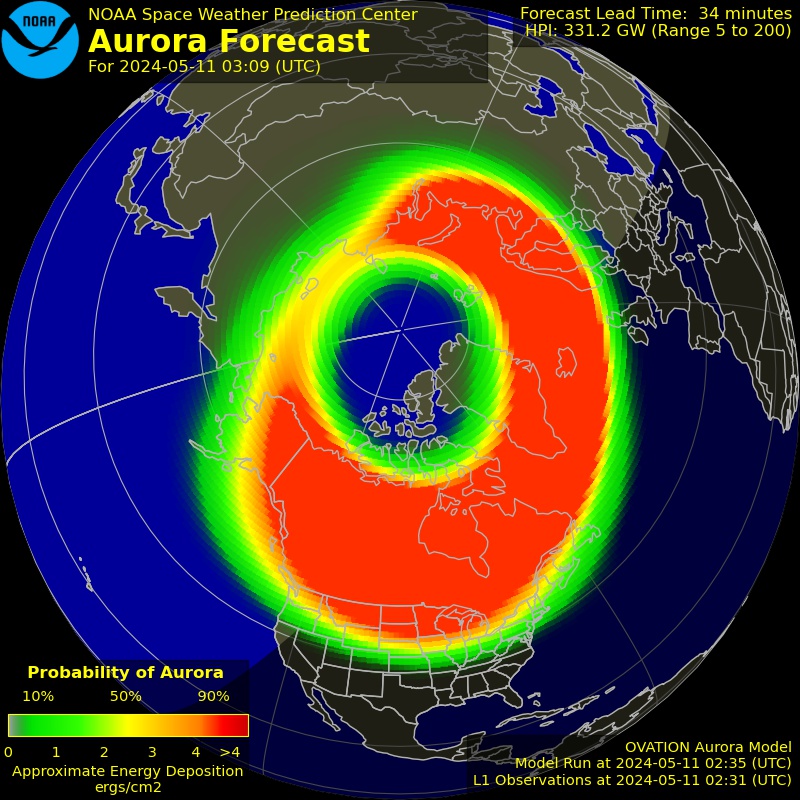
I hosted an Insider’s Guide to the Galaxy program about aurorae, with special guest expert Alan Dyer (on Twitter as @amazingskyguy), in March, 2021. To have the best chance to see the aurorae, wait for an alert, then find a dark sky (preferably moonless) and watch towards your nearest magnetic pole – north or south. If you suspect aurorae are there, but faint, try taking some long exposures with your camera on a tripod pointing north. Even a 5 or 10 second exposure can reveal colours that your eyes can’t detect! For the sure thing, one can book a trip to northern Canada or Scandinavia. Good luck!
The Moon
We’ve returned to the best week of the lunar month for viewing our natural satellite. This week the moon will be waxing in phase and shining prettily in the evening sky worldwide.
Today (Sunday) the moon will rise at about 9:30 am local time and then spend the day crossing the sky. Sharp eyes might spot its 25%-illuminated crescent in broad daylight about six fist diameters to the left (or celestial east) of the sun.
By the time the sky begins to darken after sunset on Sunday, the pretty, waxing crescent moon will be over in the western sky, forming a line with Gemini’s bright stars Pollux and Castor. Pollux, the brighter and more yellowish of the “twins”, will be close enough to the right of the moon for them to share the view in binoculars. The slightly fainter and whiter double star Castor will sparkle farther to their right (or celestial northwest). The trio will set around 1 am in your local time zone. For observers in more westerly time zones, the moon’s orbital motion will allow it to move farther from Pollux.
Use your binoculars or a backyard telescope to examine the dark patches near the curved lunar terminator. The higher one, half in shadow, will be Mare Tranquillitatis “the Sea of Tranquility”, where humans first walked on the moon. Look for subtle ripples in its otherwise smooth surface. The smaller patch closer to the moon’s centre, and also bisected by the terminator, is Mare Nectaris “the Sea of Nectar”. To give you a sense of scale, Mare Nectaris is about 860 km across and 84,000 km2, which is about the size of Ireland.
On Monday, the moon will hop east into Cancer (the Crab). If you position the moon at the upper right edge of your binoculars’ field of view that night, the stars of the large Beehive Cluster will be buzzing in the lower left portion of your view. Also designated Messier 44 and NGC 2632, its stars are scattered across a patch of sky twice the moon’s diameter. The stars in this open star cluster are all celestial siblings born from the same collapsed hydrogen gas cloud. They are travelling as a group about 580 light-years away from us in the Orion Arm of our Milky Way galaxy. The moon and planets frequently fly near the Beehive because the cluster is only one degree (a finger’s width) north of the ecliptic. Another smaller and much more distant star cluster named the Golden-Eye Cluster located less than a fist’s diameter to the lower left of the Beehive should also be visible if your sky isn’t too light polluted.

Also on Monday evening, the pole-to-pole terminator boundary between the moon’s lit and dark hemispheres will fall just to the left of a trio of large craters named Theophilus, Cyrillus, and Catharina that occupy the curved western edge of gray Mare Nectaris. Binoculars or a backyard telescope will show them easily. You can tell what order the craters were formed in by observing how sharp and fresh Theophilus’ rim appears, and by the way it has partially overprinted neighboring Cyrillus to its lower left (or lunar southwest). Under magnification, Theophilus’ terraced rim and craggy central mountain peak are evident. Cyrillus hosts a trio of degraded central peaks inside a hexagonal rim, while much older Catharina’s peak has been submerged, her edges blurred and her floor overprinted by smaller, more recent craters. I’ll post a photo of them here.
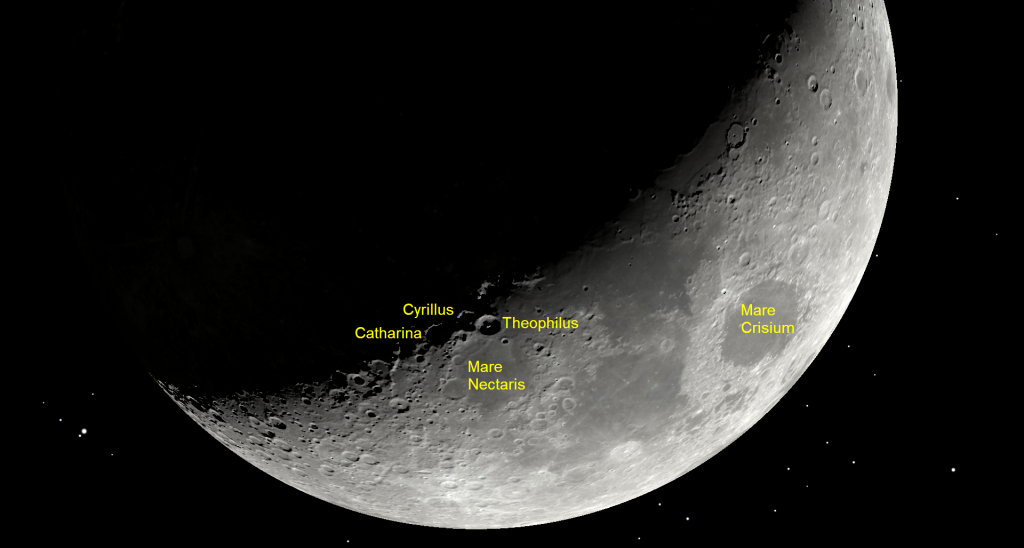
From Tuesday to Thursday the moon will traverse the stars of Leo (the Lion). At 7:48 am EDT, 4:48 am PDT, or 11:48 Greenwich Mean Time on Wednesday, the moon will officially reach its first quarter phase. At first quarter, the moon makes a 90 degree angle with the sun in the sky, appears exactly half-illuminated, and sets in the middle of the night after rising around mid-day.
The brighter, now-gibbous waxing moon will spend the coming weekend among the stars of Virgo (the Maiden). From her upraised hands to her toes, she’s more than five fist diameters across and four fists wide! Saturday night will be a fine time to view the big circular basin on the upper left portion of the moon known as Mare Imbrium “the Sea of Rains”. All of the basin will be lit by the sun. The curved mountains surrounding Sinus Iridum “the Bay of Rainbows” on Imbrium’s western “shoreline” will be especially prominent. Try to see it with your unaided eyes. You’d be amazed at the amount of detail you can see on the moon if you try.

On Sunday afternoon, May 19, the pale orb of the moon will clear the trees toward the southeast by about 5:30 pm local time. Once the sky darkens several hours later, Virgo’s brightest star Spica will be visible to the lower right (or celestial southeast) of the very bright moon. Binoculars will better show the star against the moon’s glare. As the night unfolds the moon’s continuous eastward orbital motion will be apparent as it changes its distance from Spica.
The Planets
As this week begins, five planets – Saturn, Neptune, Mars, Mercury, and Venus – will be strung like beads alongside the ecliptic in the eastern sky before sunrise. Uranus will pass the sun at solar conjunction on Monday and Jupiter will do the same on Saturday. Then they, too, will join the morning parade of planets. That means that from next Sunday onwards, all the planets (yes – Pluto, too) will be above the horizon before the sun rises. Venus and Mercury are both heading towards the sun, so they’ll leave the group on June 4 and 14, respectively. Venus is already too close to the sun for visibility.
Unfortunately, even with all the planet action in morning, only two of them will be easily visible with your unaided eyes – and only until the brightening sky hides them. The medium-bright, yellowish dot of Saturn will clear the rooftops in the east shortly after 4 am local time. Reddish Mars will join it about 45 minutes later. They’ll both shine with about the same intensity, though Mars will be a wee bit brighter. Far fainter, blue Neptune will be located midway between Saturn and Mars. On Monday morning, Neptune will be one finger’s width closer to Mars than Saturn. On next Sunday morning, Mars’ faster motion will have shifted Neptune several finger widths closer to Saturn than Mars. In any case, you’ll need a telescope to see that magnitude 7.9 planet when it’s that low in the sky.
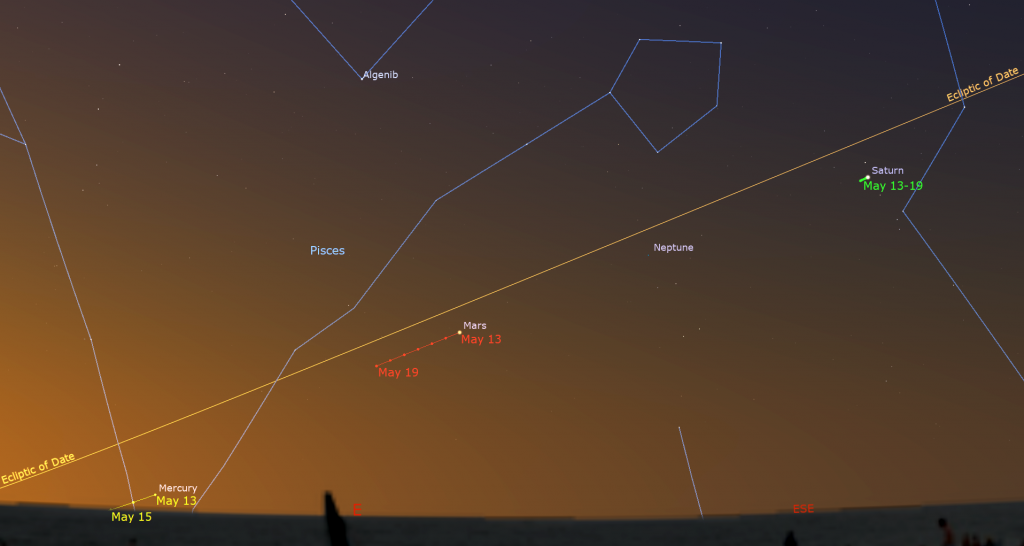
The tipped-over ecliptic is keeping all the planets low in the morning sky. As we get ever-closer to the June solstice, the ecliptic will stand up higher and lift the planets under it. Furthermore, everything is rising about half an hour earlier per week due to our orbit around the sun. For example, on July 7, Saturn will start rising before midnight and Jupiter will join the evening sky from September 4 onwards. Like Saturn, Neptune will be a star-party target from late summer on.
Saturn’s rings, which will effectively disappear when they become edge-on to Earth next March, already appear as a very narrow slash across the planet’s globe. Good binoculars can hint at Saturn’s rings and any telescope will show them. For telescope-owners, Earth’s perspective of the Saturn system this year and next will produce frequent transits of Saturn’s moons and their black shadows across its disk. In a telescope, Mars’ position on the far side of the sun from Earth will keep the planet looking small.
On Friday, Mercury reached its greatest angle (26.4 degrees) from the morning sun and maximum visibility for its current morning apparition. With Mercury positioned well below the tilted morning ecliptic, the current appearance of the innermost planet will be a poor one for Northern Hemisphere observers, but an excellent one for those living in the tropics and the Southern Hemisphere. The optimal viewing times at mid-northern latitudes will start around 5:30 am local time. Viewed in a telescope, the planet will exhibit a waxing, almost half-illuminated phase. Turn all optics away from the eastern horizon before the sun rises.

Next Sunday, May 19, the main belt asteroid designated (2) Pallas will reach opposition, its closest approach to Earth for the year. On the nights around opposition, Pallas will shine with a peak visual magnitude of 9.1, which is within reach of a backyard telescope. The asteroid will be located above and between the bright double star Zeta Herculis, which marks the upper right corner of Hercules’ keystone shaped body, and the star Kornephoros, which shines at Hercules’ elbow. Pallas itself will spend May sliding downward (to the celestial south) between those stars. The asteroid and nearby stars will already be climbing the eastern sky after dusk and will spend the night crossing the sky together.
The Big Dipper as a Sky Tool
At this time of year the Big Dipper asterism, part of the larger constellation of Ursa Major (the Big Bear), sits overhead on the zenith after dusk. When viewed while facing northeast, the dipper’s downward-facing bowl spills into its little counterpart, and its handle points to the right.

Extending the line connecting Merak at the bottom of the bowl to Dubhe at its outer rim will always lead to Polaris, the North Star. Some call those two bowl stars the Pointers. Continue the arc of the dipper’s handle and “Arc to Arcturus”, the bright orange star in Böotes (the Herdsman). Continue the arc farther to “Spike to Spica”, the brightest star in Virgo (the Maiden). Extending a line from the double star Mizar at the bend of the dipper’s handle, and diagonally through the dipper’s bowl stars, you will “Cast to Castor” in Gemini (the Twins).
You can use the Big Dipper to practice how to specify how far apart in the sky objects are. The depth of the bowl is 5 degrees. For most people, that’s equivalent to three or four finger widths (with your hand at arm’s length). The width across the bowl is 10 degrees, or about a clenched fist’s width. The length of the dipper from the star Alkaid at the handle-tip to Dubhe at the far rim, is 25 degrees. Most people can span this with a surfer’s salute – outstretched thumb-tip to pinky fingertip. Kids’ hands are smaller, so the angles I quoted above will be smaller for them.

And don’t forget that the moon covers only half of a degree of the sky – so even a child can cover it completely with the tip of a pinky finger at arm’s length. Try it this week!
Public Astronomy-Themed Events
Every Monday evening, York University’s Allan I. Carswell Observatory runs an online star party – broadcasting views from four telescopes/cameras, answering viewer questions, and taking requests! Details are here. They host in-person viewing on the first clear Wednesday night each month. Other Wednesdays they stream views online via the observatory YouTube channel. Details are here.
Taking advantage of the crescent moon in the sky this week, the RASC Toronto Centre astronomers will hold their monthly City Sky Star Party in Bayview Village Park (a short walk from the Bayview TTC subway station), starting after dusk on the first clear weeknight this week (Mon, Tue or Thu only). Check here for details, and check the banner on their website home page or Facebook page for the GO or NO-GO decision around 5 pm each day
Eastern GTA sky watchers are invited to join the RASC Toronto Centre and Durham Skies for solar observing and stargazing at the edge of Lake Ontario in Millennium Square in Pickering on Friday evening, May 17, starting at 6 pm. Details are here. Before heading out, check the RASCTC home page for a Go/No-Go call – in case it’s too cloudy to observe.
On Saturday, May 18 from 9:30 pm to 11:30 pm, RASC Toronto Centre will host Family Night at the David Dunlap Observatory for visitors aged 7 and up. You will tour the sky, visit the giant 74” telescope, and view celestial sights through telescopes if the sky is clear. This program runs rain or shine. Details are here, and the link for tickets is here.
Spend some time in the other dome at the David Dunlap Observatory! On Saturday, May 25, you can join me in my Starlab Digital Planetarium for an interactive journey through the Universe at DDO. We’ll tour the night sky and see close-up views of galaxies, nebulas, and star clusters, view our Solar System’s planets and alien exo-planets, land on the moon, Mars – or the Sun, travel home to Earth from the edge of the Universe, hear indigenous starlore, and watch immersive fulldome movies! Ask me your burning questions, and see the answers in a planetarium setting – or sit back and soak it all in. Please note that all guests will sit on a clean floor. A registered adult must accompany all registered participants under the age of 16. We run sessions geared to junior astronomers in the morning and family sessions in the afternoon. Registration is required. More information and the registration links are here.
Keep your eyes on the skies! I love getting questions and requests. Send me some!